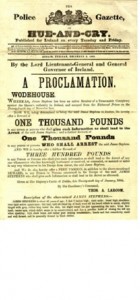The Police Gazette or Hue-and-Cry Ireland was published in Dublin every Tuesday and Friday by Alexander Thom & Co., and is almost alway s referred to as Hue-and-Cry It is unclear when Hue-and Cry and was first published in Ireland and exactly how much of the publication survives. The National Library of Ireland’s holding runs from 1837 to 1917, with some gaps. This was the official newspaper of the Royal Irish Constabulary and notices placed in the paper were distributed to all police divisions.
s referred to as Hue-and-Cry It is unclear when Hue-and Cry and was first published in Ireland and exactly how much of the publication survives. The National Library of Ireland’s holding runs from 1837 to 1917, with some gaps. This was the official newspaper of the Royal Irish Constabulary and notices placed in the paper were distributed to all police divisions.
Hue-and-Cry contains notices and reports from the 32-counties regarding felonies, together in many instances with the names and descriptions of those wanted by the police. It also contains the names and particulars of habitual criminals recently released from prison under police supervision. The supervision periods for these individuals ranged from 2 to 7 years. Hue-and-Cry includes descriptions of young offenders who had absconded from reformatories, descriptions of stolen cattle, sheep and horses as well as rewards offered for the arrests of wanted felons.
This Supervision list replaces earlier lists of ‘Deserters from Her Majesty’s Service [Ireland]’. Information contained in Hue-and-Cry for these men include name, regiment, place of birth, trade, age, height, physical description, place of desertion and marks and remarks on the deserter.
Notices were also placed in Hue-and-Cry by English and Scottish Police who believed that felons wanted by them might try and escape to Ireland
Some of the most lengthy descriptions of wanted felons were placed in Hue-and-Cry by the Dublin Metropolitan Police, G Division. An example on the extent of information recorded in Hue-and-Cry can be gauged by the notice placed for the runaway convict, John McGrath, in the issue of Tuesday 6th January 1880:
Particulars relative to Convict John M’Grath, 14358, convicted at Longford, Co. Longford, at Trinity Sessions, on 23rd June 1875, for assault occasioning actual bodily harm, and sentenced to 5 years penal servitude – 46 years of age on conviction, can read and write, is a Roman Catholic, married, has one child, is a shoemaker, born at Granard, resided at conviction at Granard, his friends reside at Longford; dark brown hair mixed with grey, brown eye (right eye blind), brown eyebrows, regular nose, medium mouth, fresh complexion, pockmarked oval visage, medium make, 5 feet 6 inches high, a number of small blue marks under right eye, and on left cheek and forehead from the effect of an accident by powder, body very much marked with small-pox; large scar in left groin, varicose veins in left leg, lost one front and number of upper back teeth.
The convict was released on licence from Spike Island Prison, 24th June 1879; he left his residence without notifying same to the Metropolitan Police, and his present whereabouts are unknown.
John McGrath was reported as being arrested in Hue-and-Cry on 6th February 1880.
Needless to say, Hue-and-Cry contains offers of rewards for some of Ireland’s most infamous felons and radical politicians. In January 1867 and for much of the next six months the entire front page of Hue-and-Cry was given over to the rewards offered for information leading to the arrest of James Stephens, the leader of the Irish Republican Brotherhood.
Hue-and-Cry represents an extremely valuable source to the Irish genealogist, containing as it does, numerous references to personal names, in the form of missing persons, felons, army and navy deserters and habitual offenders.
